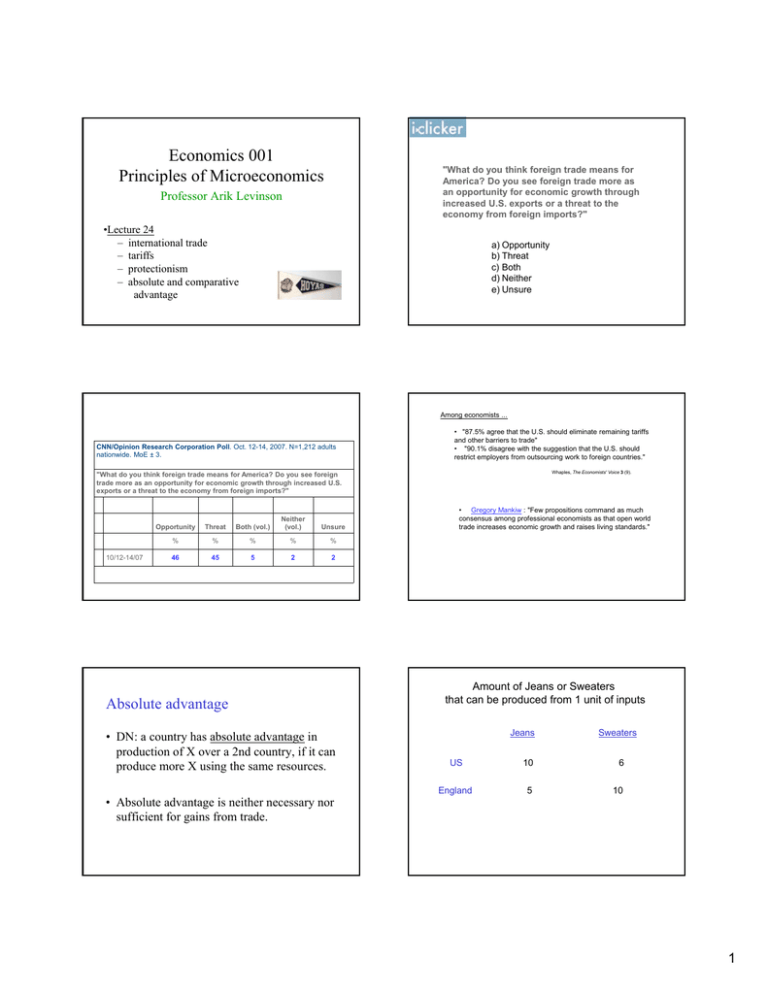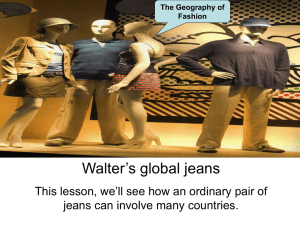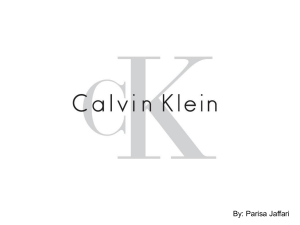Economics 001 Principles of Microeconomics
advertisement

Economics 001 Principles of Microeconomics "What do you think foreign trade means for America? Do you see foreign trade more as an opportunity for economic growth through increased U.S. exports or a threat to the economy from foreign imports?" Professor Arik Levinson •Lecture 24 – international trade – tariffs – protectionism – absolute and comparative advantage a) Opportunity b) Threat c) Both d) Neither e) Unsure Among economists ... CNN/Opinion Research Corporation Poll. Oct. 12-14, 2007. N=1,212 adults nationwide. MoE ± 3. • "87.5% agree that the U.S. should eliminate remaining tariffs and other barriers to trade" • "90.1% disagree with the suggestion that the U.S. should restrict employers from outsourcing work to foreign countries." Whaples, The Economists' Voice 3 (9). "What do you think foreign trade means for America? Do you see foreign trade more as an opportunity for economic growth through increased U.S. exports or a threat to the economy from foreign imports?" . Threat Both (vol.) Neither (vol.) % % % % % 46 45 5 2 2 Opportunity 10/12-14/07 Unsure Absolute advantage • DN: a country has absolute advantage in production of X over a 2nd country, if it can produce more X using the same resources. • Gregory Mankiw : "Few propositions command as much consensus among professional economists as that open world trade increases economic growth and raises living standards." Amount of Jeans or Sweaters that can be produced from 1 unit of inputs Jeans Sweaters US 10 6 England 5 10 • Absolute advantage is neither necessary nor sufficient for gains from trade. 1 Now change 1 unit of US resources into Jeans and 1 unit of England resources into Sweaters Sweaters 160 WORLD PPF Jeans Sweaters 100 (100, 100) Eng. PPF US +10 -6 England -5 +10 60 US PPF World gains: +5 +4 50 100 150 Jeans What if the US better at both Jeans and Sweaters ? US England Jeans Sweaters 100 60 5 10 Now change 1/10 unit of US resources into Jeans and 1 unit of England resources into Sweaters Jeans US Sweaters +10 -6 England -5 +10 World gains +5 +4 Comparative advantage • DN: a country has comparative advantage in production of X over a 2nd country, if the opportunity cost of producing X in the first country is lower than in the 2nd country. • Comparative advantage is necessary and sufficient for gains from trade. Translate Comparative Advantage into Opportunity Costs US England Jeans Sweaters 100 60 5 10 Opportunity Costs Jeans Sweaters US 0.6 sweaters 1.67 jeans England 2 sweaters 0.5 jeans 2 TARIFFS Free trade example: US Jeans P England Jeans P D S D S US Sweaters P SUS P Q Q England Sweaters P D DWL from producing the wrong way D DWL from consuming less than optimal (MB > MC) PW +t t=tariff Government Gain producer Lost Consumer Surplus revenue surplus PW S DUS Imports w/ tariff S Q Q SUS DUS Q Imports w/ free trade 3






